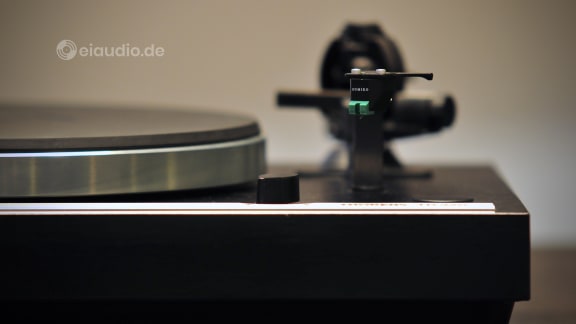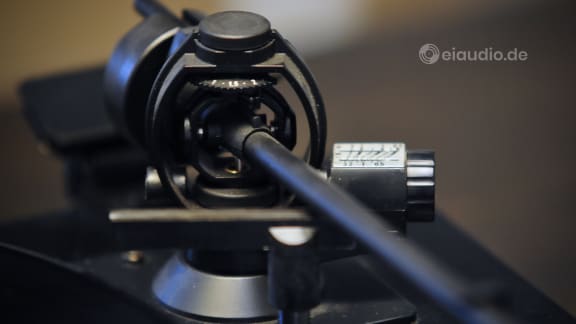Thorens TD320
Published: 10/03/2022
Manufacturing date: 1986
Author: Karsten Hein
Category: Gear & Review
Tag(s): Turntables
For many years, the Thorens DT 320 headed my list of most desirable affordable turntables, as it already boasted some audiophile features that would only find their way into modern 'High-End' designs much later. When it was first released to the public in 1984, the TD 320 was the top of the Thorens 300-series and was also more generally considered to be top-of-its-class. Early models came equipped with the TP16 MK-III tonearm. Later, this was succeeded by the MK-IV tonearm which was also featured on the model shown here. This places our specimen in the model years from 1986 to 1988. The 300-series was among Thorens’s most successful model ranges and was later extended with some new and revised versions: the TD 325, TD 2001, and the TD 3001.
The TD 320 featured a suspended sub-chassis hinged on 3-point leaf springs that held the tonearm and platter separated from the vibrations of the motor. The use of leaf springs proved to be beneficial when compared to earlier coil spring designs, as they limited wobble on the horizontal axis. To eliminate the effect of transformer vibrations, the TD 320 came with a separate power supply. And although the original Thorens supply was simply built into the AC plug, power supply upgrades were among the first and most viable tuning choices for the TD 320. The power supply that is shown here was sold by the French audio distributer 'Audiophonics'. It is of linear low-noise design and has dedicated EMI and RFI filters. Its output is rated at 1.25 A and 16 V. Placing the power supply on a separate shelf-board will effectively eliminate power supply vibrations from the music signal.
The Thorens TP16 MK-IV tonearm featured adjustable horizontal and vertical bearings to keep the amount of arm play to a minimum. The black dust cap on top of the pivot could be removed to allow easy access to the top bearing. Unlike many of its foreign contemporaries, the MK-IV tonearm came with a fixed headshell that could not easily be swapped around. Its sleve wrapped around the arm’s aluminum tube and was fixed with a single screw. The vertical tracking angle (VTA) of the cartridge and stylus combination could be adjusted by loosening the screw and twisting the headshell into position. There were, however, some flaws with this crude system. For one thing, twisting the headshell on the arm could have a negative or even damaging effect on the fragile tonearm bearings. Second, removing the arm from the overly tight tonearm clamp on a regular basis could negatively affect the VTA setting. And, third, tightening the headshell screw almost inevitably altered the vertical tracking angle again in an unpredictable manner. On the other hand, the arm’s no-frills, anti-skating mechanism could also be conveniently set via a single screw. This affected the position of permanent magnets and actually worked quite well.
When I picked up our TD 320 from a private seller in the Taunus region near Frankfurt, it was in arguably poor condition. Its wood veneer had lost most of its lustre, its dust cover had been deeply scratched. The 3-point suspension had come loose on the inside, and the platter was lopsided and scraping over the plinth with each turn. The drive belt was loose and needed replacement, and the original yellow Linn-branded pickup (made by Audio Technica) had a badly-worn stylus. I placed the Thorens on the back seat of our car and wondered how much time and effort it would take to restore this once great turntable to its original splendour.
I bought a new drive belt from Thakker.eu, fixed and adjusted the 3-point suspension until it held the arm-board at the correct height and level again. I used furniture polish to restore the original wooden shine of the plinth. Following a short interlude with a Sumiko Olympia cartridge (which I ended up sending back to Thakker), I installed our Audio Technica VM95 ML cartridge with a very positive result. Since both the Sumiko and the Audio Technica had a lower body than the original cartridge, I also needed to adjust the tonearm-height for the arm to be level with the record during playback. I replaced the original power supply with the one from Audiophonics and removed the original felt pads under the plinth to replace them with height-adjustable copper spikes. Determined to restore the dust cover, I showed it to my friend Thomas who is an expert on car body work and paint jobs. He offered to sand it down and polish it for me. When he returned it to me one week later, the scratched, old cover looked as though it had come fresh from the shop.
Listening to music on the TD 320 with an Audio Technica VM95 ML cartridge produced a warm, balanced and natural sound. Background noise was low, and channel separation was great. There was a sense of elegant delicacy that was embedded in believable tonality and excellent musical flow. The VM95 ML was a superb tracker and worked well with the TP16 MK-IV tonearm. The Sumiko, on the other hand, had seemed more bottom heavy and much less refined with continuous distortion and sibilance, especially towards the inner groove of records, which was also the reason for me sending it back to the shop. I found that the TD 320 in combination with the Audio Technica VM95 ML lent itself to classical music and Jazz and to those seeking a laid back and insightful sound rather than in-your-face attack. It was perhaps not the most enthralling combination, and I sometimes wondered how a louder and more boisterous Ortofon 2M Bronze cartridge might perform in the balance of things.
There are still some design flaws to the TD 320 which I might address at a later stage. For example, a look under the hood revealed that the audio signals were in fact running in parallel with some of the power and switching electronics, a circumstance I intend to change for greater dynamics and transparency. There was also the questionable quality of the interconnects themselves that had come pre-installed on the turntable. One could possibly get a better result by changing to a silver solid-core interconnect from our trusted HBS series. Both the platter and the plinth floor might benefit from additional damping matts being applied. The sub-chassis might be re-adjusted to allow for the use of an additional record weight, etc. However, for the time being, I was indeed very happy to have given new life to one of the all-time legends in the world of turntable designs. I understood that there was a lot more fun to be had with the TD 320 than with any of the sleek and modern direct-drive decks from Japan. Although, the Thorens was more complicated to deal with on a daily basis and screamed: Caution, handle with care!
Thorens Company History
Thorens was originally founded in the town of Sainte-Croix, Switzerland, in 1883. Similar to the German Dual, Thorens started out as a specialist for clock movements before producing phonographs from 1903. The company’s first turntables date back as early as 1928. This makes Thorens one of the oldest existing producers of turntables in the world.
During the 1950s and 1960s, Thorens produced a range of sophisticated turntables for private and professional use that continue to be regarded as audiophile High-End equipment. The TD150 MK II was produced for the private market from 1965-1972, and the heavy-built TD 124 was found among audiophiles and studios alike. It was produced from 1957 to 1965.
Following its insolvency of 1999, the newly formed 'Suisse Thorens Export Company' took over the Thorens assets and continued to produce and sell Thorens turntables under the leadership of Heinz Roher. In May 2018, Gunter Kürten took over the company and moved its headquarters to Bergisch Gladbach in Germany. Current models include the TD 124 DD, the TD 1500 with TP 150 tonearm and SME headshell, and the similarly equipped TD 403 DD.
Specifications
- Drive method: one step belt drive
- Motor: 16-pole synchronous motor, 16V
- Platter speed: 33 and 45rpm
- Speed control: 2-phase generator
- Platter: 3.1kg, 300mm, zinc alloy, dynamically balanced
- Wow and flutter: 0.035%
- Rumble: > -72B
- Tonearm: TP16 MK IV
- Tonearm length: 232mm
- Pivot to spindle: 215.6mm
- Effective mass: 12.5g
- Overhang: 16.4mm
- Offset angle: 23 degrees
- Dimensions: 440 x 350 x 170mm
- Weight: 11kg (plus power supply)
- Power supply: Audiophonics LPSU25 (China)
- Supply type: 25VA, linear regulated, EMI RFI filters
- Country of manufacture: Germany
- Year(s): 1986-1988





